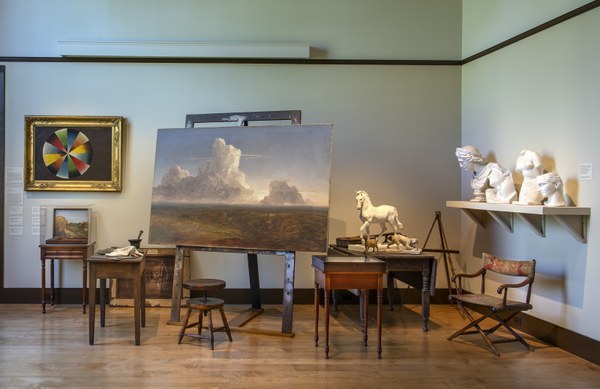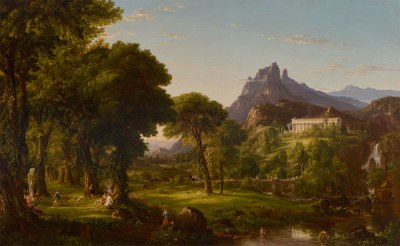Thomas Cole's Studio: Memory and Inspiration
November 19, 2022–February 12, 2023. Explore the significance of Cole’s late work for art in the United States.

Thomas Cole's Studio: Memory and Inspiration installation view © Peter Aaron OTTO
Thomas Cole, Dream of Arcadia, about 1838, Oil paint on canvas; 38 ⅝ × 62 ¾ in. (98.1 × 159.4 cm), Denver Art Museum: Gift of Mrs. Lindsey Gentry, 1954.71, Image courtesy of the Denver Art Museum
The exhibition was organized by the Thomas Cole National Historic Site. Thomas Cole’s Studio: Memory and Inspiration was supported in part by an award from the National Endowment for the Arts. Major support was provided by the Barrie A. and Deedee Wigmore Foundation. Additional support was provided by Candace and Rick Beinecke, and Richard T. Sharp.
The exhibition and publication were also supported by the Warner Foundation, The Lunder Foundation, Lisa Fox Martin, Anne Miller and Stuart Breslow, Greene County Legislature through the Greene County Cultural Fund, administered in Greene County by CREATE Council on the Arts, Stainman Family Foundation, National Trust Insurance Services, LLC, The Bank of Greene County Charitable Foundation, Stephen Hannock, Annette and Stanley Blaugrund, New York State Council on the Arts with the support of the Office of the Governor and the New York State Legislature, and the Kindred Spirits Society of the Thomas Cole National Historic Site.
Additional support was provided by the City of Albuquerque Department of Arts & Culture and the Albuquerque Museum Foundation.
CATALOG
The exhibition was accompanied by a fully illustrated catalog published by Hirmer Publishers that includes a principal essay by Franklin Kelly, as well as essays written by Annette Blaugrund; William L. Coleman, Director of Collections at The Olana Partnership; and Lance Mayer and Gay Myers, acclaimed painting conservators.
Albuquerque Museum was proud to present Thomas Cole’s Studio: Memory and Inspiration curated by Franklin Kelly, senior curator at the National Gallery of Art. The exhibition reassembled the paintings that were in Cole’s studio when he died in 1848 and explores the significance of Cole’s late work for art in America. Thomas Cole was the founder of the Hudson River School. This group of painters established an iconic style of American landscape painting.
This exhibition was presented simultaneously with three other exhibitions featuring contemporary artists that engage the natural world through diverse depictions of the landscape: Kiki Smith: From the Creek, Shi Guorui: Ab/Sense – Pre/Sense, and Nicola López and Paula Wilson: Becoming Land.
Thomas Cole was already the most famous landscape painter in the United States when he died unexpectedly at the age of 47 in February 1848. His legacy continues to influence American art to this day, and a new exhibition Thomas Cole’s Studio: Memory and Inspiration explored the creative directions of the painter’s last years, the rich and diverse group of works left in his studio at his death, and how his example so powerfully affected the evolution of art in America. The exhibition’s curator was Franklin Kelly, senior curator and Christiane Ellis Valone, curator of American Paintings at the National Gallery of Art. The exhibition was organized by the Thomas Cole National Historic Site, where it debuted April 30 to October 30, 2022.
Thomas Cole’s death shook the American art world. Poet and journalist William Cullen Bryant wrote that Cole’s death left “a vacuity which amazes and alarms….” It was as if one of the “grandest summits” of the Catskill Mountains had suddenly disappeared.
In December 1846, Cole set up his studio in a new building of his own design and filled it with works from all phases of his career, including finished paintings, sketches, and drawings. In this “New Studio,” Cole began working on landscape paintings that were often large in scale, and among the most powerful and complex he had ever created. At his death, after little more than a year of using the studio, most of those works – including the five-canvas The Cross and the World, a successor to his famous series paintings, The Course of Empire and The Voyage of Life – and Cole’s own grand ambitions for the rest of his career remained unrealized.
Cole’s family maintained the New Studio after his death as a shrine to his memory, allowing visitors to experience it just as it had been and draw inspiration from all that it conveyed about him and his art. On entering, they were immersed in Cole’s world – the room where he painted, with a vista of the Catskill mountains that inspired him. When the renowned American artist Jasper Cropsey was there in 1850, he wrote in a letter, “it seemed as if Mr. Cole would…be in in a few minutes, for everything remains as when he last left painting…. Though the man has departed, yet he has left a spell behind him that is not broken.”
That act of preserving the New Studio proved crucial to maintaining and expanding Cole’s legacy and ensuring his profound influence on art in America. For many years it provided the largest and most comprehensive collection of work by this renowned artist available anywhere. For the painters who would bring landscape to national prominence in mid-nineteenth-century America, including Asher B. Durand, Frederic Edwin Church, John F. Kensett, and Susie Barstow, Cole’s unbroken “spell” would indeed prove of key generative influence in fulfilling his legacy.
The New Studio was unusual: a freestanding purpose-built building designed by the artist himself. While Thomas Cole is best-known today as the founder of the nation’s first major art movement, now known as the Hudson River School of landscape painting, he was also an architect. He designed several buildings that were constructed, most notably the Ohio State Capitol in Columbus and St. Luke’s Church in Catskill. Other buildings that he designed were his temporary studio in the storehouse on the property, which he used for seven years until he built the now-reconstructed New Studio, which is operated today as a museum at the Thomas Cole Historic Site.
The exhibition presented a selection of artwork and artifacts to serve as the first reimagining of what visitors would have seen upon entering the New Studio. It contained 26 oil paintings by Thomas Cole from the collections of the Thomas Cole National Historic Site and such other renowned institutions as the National Gallery of Art, The Metropolitan Museum of Art, Smithsonian American Art Museum, Albany Institute of History & Art, Crystal Bridges Museum of American Art, Pennsylvania Academy of Fine Arts, Wadsworth Atheneum, and other public and private collections. Also included in the exhibition were the artist’s graphite drawings and sketches in oil and pen, as well as a recreation of his working studio environment, that includee Cole’s original easels, paint box, brush, palettes, plaster model casts, geological specimens, and guitar.
The exhibition was informed by the 1850 letter by Jasper Cropsey detailing many of the things that were present in the studio, as well as photographs taken by the Cole family of the preserved space later in the 19th century, and new research in letters, inventories, and documents conducted at the Thomas Cole Site by Franklin Kelly and others. In creating this exhibition, Kelly hae been joined by Consulting Curator Annette Blaugrund, the independent scholar and author of Thomas Cole: The Artist as Architect, and Kate Menconeri, chief curator and director of curatorial affairs, Contemporary Art, and Fellowship at the Thomas Cole Historic Site, both of whom coordinated the exhibition and edited the accompanying catalog.
“I have imagined organizing an exhibition on this topic since I was a graduate student,” said Franklin Kelly. “Many years ago, when I first visited what is now the spectacular Thomas Cole Site, I only saw then an abandoned home in great need of repair. The New Studio was no longer standing, but I found its foundation and wondered about Cole’s brief time working there and what was left after his death that had been of such inspiration to so many other artists. It is thrilling to reassemble a selection of the art and artifacts known to have been in the New Studio and show it to new generations.”
“When we reconstructed Thomas Cole’s New Studio as an exhibition space several years ago, we hoped that we could one day bring back the art and artifacts that used to be inside it,” said Elizabeth B. Jacks, executive director of the Thomas Cole National Historic Site. “It would not have happened without the extraordinary scholarship, passion, and determination of Franklin Kelly. Thanks to everyone involved in this exhibition, it now opens the door to a thoroughly new appreciation of Thomas Cole’s final paintings and the impact of this magical place on American art “
The Thomas Cole National Historic Site
The Thomas Cole National Historic Site is an international destination presenting the original home and studios of the artist and early environmentalist Thomas Cole (1801-1848). Cole founded the first major art movement in the United States, now known as the Hudson River School of landscape painting. Located on 6 acres in the Hudson Valley, the site includes the 1815 Main House; Cole’s 1839 Old Studio; the reconstructed 1846 New Studio building; and panoramic views of the Catskill Mountains. It is a National Historic Landmark and an affiliated area of the National Park System. The Thomas Cole Site’s activities include guided and self-guided tours, special exhibitions of both 19th-century and contemporary art, print publications, lectures, extensive online programs, school programs, the Cole Fellowship, free community events, and innovative public programs such as the Hudson River School Art Trail—a map and website that enable people to visit the places in nature that Cole painted—and the Hudson River Skywalk, a new scenic walkway connecting the Thomas Cole Site with Frederic Church’s Olana over the Hudson River. The goal of all programs at the Thomas Cole Site is to enable visitors to find meaning and inspiration in Thomas Cole’s life and work. The themes that Cole explored in his art and writings—such as landscape preservation and our conception of nature as a restorative power—are both historic and timely, providing the opportunity to connect to audiences with insights that are highly relevant to their own lives.

